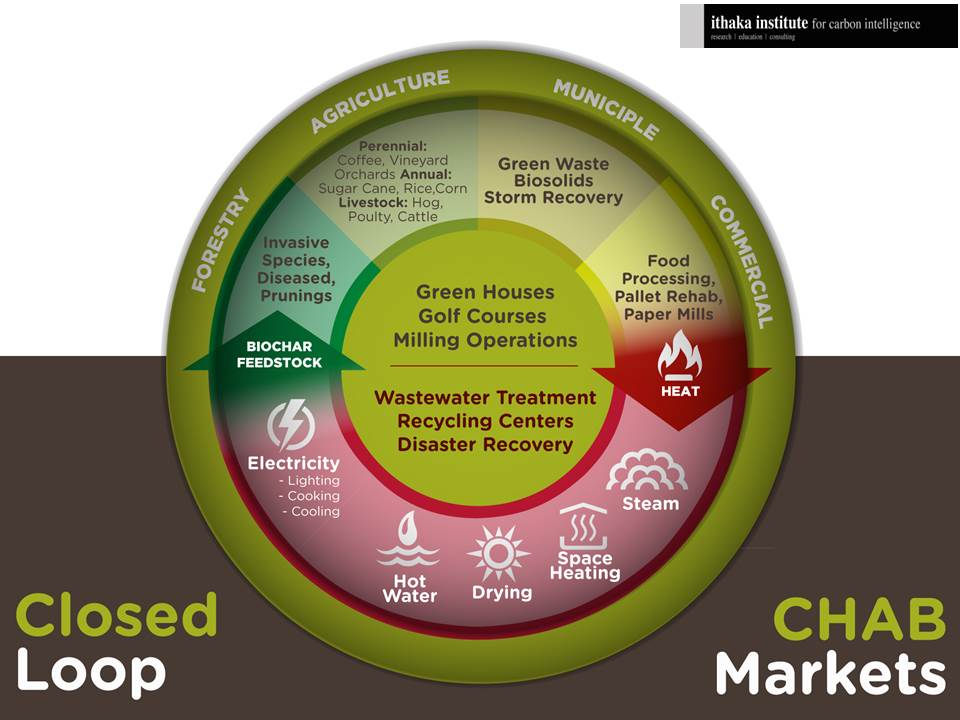[Part II of a recent presentation I gave at the NE Biomass conference.
Given the emergent nature of markets for biochar at this point in time, my personal opinion is that in the short term it might be best to focus on closed loop scenarios where feedstock, heat and biochar are all provided and used within the same environment. As with my previous post on Biochar Markets, this graphic is not meant to be exhaustive but rather indicative of possible uses for heat, types of available biomass and potential CHAB markets.
Agriculture is one of the largest sources for underutilized biomass whether it is from perennial or annual crops or from livestock. Most of this biomass can be converted into biochar, although some is easier and cheaper to process than others and some biomass makes much better biochar than other feedstock. To take one example, albeit not a local one, coffee generates massive amounts of waste, most of which isn’t usable for many other purposes given high tanins and other content. Converting coffee pulp or tree prunings into biochar and using the heat to dry coffee cherries could allow farmers to sell their harvest as a higher value commodity. They could then use the char on-farm to improve soil resiliency and crop yield which reducing fertilizer costs.
For an example closer to home, maple sugar producers could use a customized CHAB unit as an evaporator for converting sap to syrup and then use the char around the trees to help them manage drought better and to counter-balance acidic soils, something which I’ve heard is a bit of a problem in parts of this region.
Poultry farms are another great closed loop example. While poultry litter does make a great natural fertilizer, often times there is an excessive amount and no nearby markets, especially during winter months when spreading is difficult or not allowed. Poultry litter can make an excellent feedstock for biochar as it has a relatively high nutrient content compared to other feedstocks. Heat can be used in hen houses and biochar can be used as part of the litter or used in wall structures to reduce odors related to ammonia.
At the municipal level, many towns and cities are desperately looking for ways to reduce the amount of organics sent to landfills. Yard waste and the like could be chipped for CHAB systems and the heat used at recycling centers while the biochar could be used by Parks & Recreation departments or provided to taxpayers. An example of this model will soon be found in Stockholm, Sweden as the project won funding from the 2014 Mayors Challenge. Mobile CHAB units which could be shared within a region would be very helpful in handling storm debris and providing heat which could be used for melting snow or used in emergency shelters if needed.
There are countless examples where CHAB technology makes a lot of sense in the commercial realm. Many golf courses tend to have a lot of tree debris and could definitely use the biochar to reduce compaction and improve water management especially out west. Or they could use the char to reduce nutrient leaching into surrounding water bodies. The heat could be used, at least in the cooler months, to heat club houses. Systems that can convert heat to electricity would be especially useful for golf courses.
Another example is related to milling operations. To take coffee again as an example, often this waste is either dumped or burned at the mill level. Converting this into heat and biochar would provide heat for additional drying processes and char which could be used to filter waste water, used in the fermentation process, or used in cement mixes to create drying pavements or storage warehouses or sold as an additional revenue stream.
Sugar cane mills also provide another closed loop possibility. In one operation down in Costa Rica the fibrous leftovers, called bagasse, are converted into biochar while the heat is used to make steam which is used for the boiling process. The biochar is used on sugar cane fields and also sold to plant nurseries.
These are but a few examples where combined heat & biochar technologies could be used. Once a market for biochar is more established, there are likely to be even more potential customers for CHAB technologies. However since selling biochar is unlikely to be part of the core business for some of these customers, they are likely to be more interested if off-take agreements can be established for any biochar produced.


